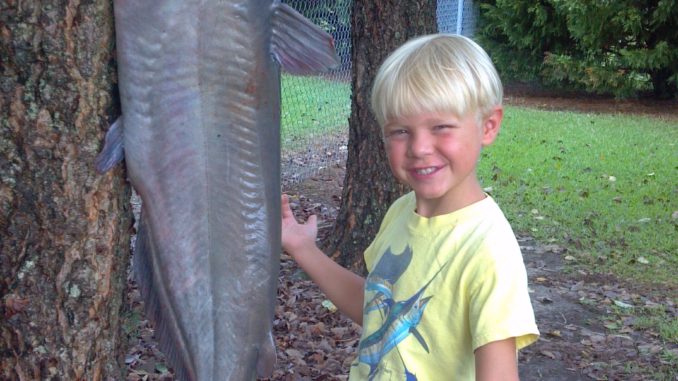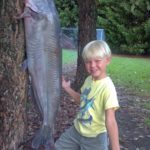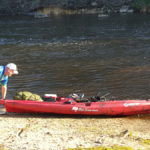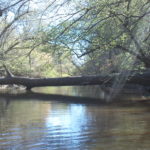
Contentnea Creek winds through eastern North Carolina, providing anglers with plenty of places to hook up with channels, blues and flatheads
Hidden in North Carolina’s coastal plain, Contentnea Creek is unknown to most fishermen, but locals know it well and consider it a treasure. After all, the name Contentnea is derived from a Native American phrase meaning “fish passing by.”
While its headwaters are near Raleigh, the creek officially begins as it leaves Buckhorn Reservoir in Wilson County. From there, it flows into Wiggins Mill Reservoir and again below the dam at Wiggins Mill at US 301 in Wilson. Eventually, it meanders its way to the Neuse River near Grifton.
The banks below the US 301 bridge are often dotted with fishing buckets and shore anglers. Water levels vary greatly due to weather.
Like any other creek or river in the central and eastern parts of the state, Contentnea holds a lot of different species, and one of the secrets hidden in this treasure is an abundance of catfish.
Other than bank fishing, one of the more-popular ways to tackle the creek and its catfish is by floating downstream. The best way to float it depends on the section to be targeted. Putting in below the dam at Wiggins Mill is one of the harder tracks to try. While there are few whitewater locations, the creek is narrow, and there are fallen trees spanning from bank to bank in many places. Taking a canoe or kayak lightens the load when portaging that a john boat will not allow.
Tim Daniels owns land along the creek and remembers stories of the water being deep enough for small barges to travel from the Neuse upstream past Snow Hill. He says at many points along the creek, the water gets shallow enough during long periods of drought that you can see the catfish scouring the bottom.
Contentnea fishes almost like two separate bodies of water, with deep and shallow sections. Catfish can be found in either, if you know how to look for them.
In many creek bends, you can white sand washed up to form a shallow shoal. Just a few feet from the sandy areas, the water drops quickly, and catfish will lurk in the depths waiting for bream, shad, and even small bass.
Pull onshore just before or after one of these bends for a float break or overnight camp. Set up a few rods with a light drag or even an open bail on a spinning reel. Using stinkbait and cut bait anchored down by 2- or 3-ounce weights can produce results in both quantity and size. Circle hooks are effective in allowing the catfish to take the bait and hook themselves. If fishing at night, use a line clicker to alert you if a catfish hits the bait and takes off.
In the long, straight passages, catfish can still be found in the deeper waters, trolling the bottoms, but the fallen trees and holes created by erosion in the roots of other trees provide cover for both smaller fish and places for catfish to back into and wait to ambush them.
Fishing live bait slowly along the sides mimics real life. The catfish will pounce on a live shad floating by. Set the live bait under a large float or cork that allows the fish to swim in the bottom third of the water column. In most places, this may only be in 5 to 8 feet of water, depending on recent rainfall.
Where water breaks over fallen trees or rocky bottoms, look for catfish just beyond the water turmoil. They will look for prey that becomes disoriented from the mixed water and swirls. Dead shad, cut bait and even weighted soft plastics such as worms, crawfish and small fish will entice catfish to bite.
Even in the shallows, large catfish can lay in wait, so do not be fooled into thinking a 2- or 3-pounder is the likely result. Contentnea Creek is unpressured, especially in the stretch from Wilson to Stantonsburg, with only a few spots that you may run into bank anglers. Again, this area is also the hardest to navigate due to downed trees and lack of boating access.
From Stantonsburg — near the Woodbridge Road bridge — down to Snow Hill, things clear up pretty well, and john boats with electric motors or even small, gasoline motors can be spotted fairly often. The water is both deeper and wider.
If you attempt an overnight stay, look for the many flat banks on which to camp, but also pay attention to the No Trespassing signs and purple-banded trees signifying posted land. Most of the creek is undeveloped but is still owned by farmers and other landowners and much of it is leased to hunting clubs. As always, practice the “Leave No Trace” methodology and carry out all of your trash.
If floating by kayak or canoe, you can access Contentnea Creek just below the Wiggins Mill Dam at the US 301 bridge. The water is often shallowest there, and there are two whitewater areas caused by rocky bottoms over the next quarter-mile.
The furthest access upstream for john boats and other motorized boats is a ramp at the bridge on NC 222 in Stantonsburg. Other ramps are located on Speight’s Bridge Road off of NC 58 between Stantonsburg and Snow Hill, a public wildlife ramp in Snow Hill just off US 258, the boat ramp in Hookerton off NC 123, and the public wildlife ramp in Grifton just off NC 118.
The Wilson-to-Stantonsburg leg will take two days to float, and another two days from each ramp to the next if fishing. Always carry an extra day’s worth of provisions. Always wear a personal flotation device (PFD) whether floating to going by john boat, as it is easy to get turned sideways in quick moving water. The flow of water beneath the boat can cause an unexpected flip if you or your gear catches limbs from a fallen tree above the water line.
During the summer, there are snakes, including venomous ones. Try to stay clear of overhanging limbs and watch your steps when portaging around fallen trees or taking a float break.
Cellular service is spotty on many of the more remote places of the creek, so always provide a float plan.
DESTINATION INFORMATION
HOW TO GET THERE — Contentnea Creek becomes a navigable stream southwest of Wilson in Wilson County, and it flows to the Neuse River near Grifton. Wilson, Stantonsburg, Snow Hill and Hookertown provide the best access for fishermen in paddlecraft or john boats. Wilson is approximately 75 miles east of Raleigh is at the junction of US 301 and US 264, Stantonsburg at the junction of US 265 and NC 58, Snow Hill at the junction of US 13 and US 258 and Hookerton is on NC 123 southeast of Snow Hill.
WHEN TO GO — Catfish action picks up as the water warms in late spring and stays good through the summer.
BEST TECHNIQUES — Look for channel cats in deep water close to sandy shoals; fish cut baits or stinkbaits on circle hooks on the bottom. Live shad can be floated through deeper water under a cork for flatheads or channels.
ACCOMMODATIONS — Wilson Visitors Center, 800-497-7398, www.wilson-nc.com.
MAPS — DeLorme’s North Carolina Atlas and Gazetteer, 800-561-5105, www.delorme.com.







Be the first to comment